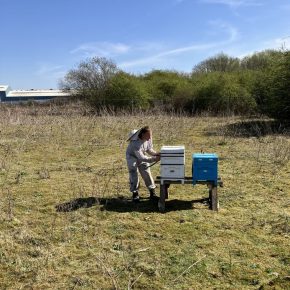
GUEST ARTICLE: Water Pollution on Construction Sites – Common Sources and Treatment Methods
Richard. D. Coulton, General Manager – Construction at Siltbuster, discusses the top causes of water pollution on construction sites, the impact it has on the natural environment and the most effective treatment options.
In 2018 the Environment Agency released its ‘Temporary Dewatering of Excavations to Surface Water’ regulatory position statement (RPS), that specified how all construction companies must have a Bespoke Permit to discharge anything other than clean water off site into the surrounding environment. This came in the context of a Leeds-based house building company being fined £120,000 for illegally polluting a watercourse.
It therefore makes sense for construction firms to understand more about the most common sources of onsite water pollution – silty waters, oil and concrete wash water – and how to treat them.
Silty Water
The most common source of pollution on construction sites is suspended solids (silt-laden waters). In fact, silty waters make up roughly 40 percent of the construction industry’s water pollution. That’s because they can arise quite easily.
When a construction site takes away the topsoil, it strips the land’s strongest defence against erosion, vegetation. The remaining surface has no protection from rainfall and run-off, so silty water enters drains and watercourses, potentially blocking the gills of fish and smothering aquatic plants by starving them of light and oxygen.
There are some practical solutions that can minimise silt pollution, however, if silty water does arise it will need dealing with – and with tankering costs being expensive, that means mastering on-site treatment techniques.
The construction of settlement lagoons will help manage suspended solids, but they take up a lot of space on site. A more compact solution is to use lamella clarifiers which are up to 20 times more space efficient than traditional baffle tanks or lagoons. For slow settling solids, a chemical dosing stage may be required to aggregate the particles and increase settling rates.
Hydrocarbons (Oils)
Hydrocarbons are commonly encountered on remediation projects in the form of petroleum-based substances such as petrol, diesel, kerosene and oils. Sources can include historical spillages that have been absorbed into the land, unmapped pipe networks still full of product or even new spillages from refuelling of plant or burst hoses.
Again, there are some practical measures construction firms can take to minimise this pollution, such as providing oil spill kits and refuelling vehicles in designated areas, however, in certain cases, such as site remediation, oil contaminated water may be hard to avoid. In such cases an oil water separator will be needed to remove the contamination, either by flotation or settlement.
High pH Water
The pH of concrete wash water is 12 to 13 – the same as oven cleaner – making it highly damaging when discharged. Despite these risks it is still misunderstood by contractors, with many allowing concrete wagons to wash out into leaky waste skips.
When it comes to dealing with such water, dilution isn’t practical or cost-effective; it takes 10,000 litres of water to get 1 litre of concrete wash water with a pH of 12 to an acceptable pH of 8.
Some suggest using mineral acids like sulphuric or hydrochloric to adjust the pH. However, these are dangerous to handle, can easily overshoot the target resulting in equally polluting acidic water and they also create ‘secondary pollutants’.
As a result, Carbon Dioxide is by far the best neutralising agent. It’s virtually impossible to acidify water using CO2, it has no hazardous by-products, is easy to store and is the most cost-effective.
Summary
There are some simple steps to minimising the risk of creating onsite water problems and dealing with them should they arise. The key is to plan – be pre-emptive rather than reactive; anticipate the problems, prepare for the unexpected and know what the solutions are.
Latest news

30th April 2025
Digital Construction Week announces seminar programme for its landmark 10th edition
Digital Construction Week (DCW) returns to ExCeL London on 4 – 5 June 2025 with its most impactful programme yet. It brings together the best and brightest from across AECO, for two days of practical learning and idea sharing.
Posted in Articles, Building Industry Events, Building Industry News, Building Products & Structures, Building Services, Building Systems, Exhibitions and Conferences, Information Technology, news, Restoration & Refurbishment, Retrofit & Renovation, Seminars
29th April 2025
Senior pledges to ‘bee’ part of the solution with new biodiversity initiative
Senior Architectural Systems has installed its first on-site beehive, marking another step forward in its commitment to sustainability and biodiversity.
Posted in Articles, Building Industry News, Building Products & Structures, Building Services, Curtain Walling, Doors, Glass, Glazing, Innovations & New Products, news, Restoration & Refurbishment, Retrofit & Renovation, Sustainability & Energy Efficiency, Walls, Windows
29th April 2025
West Fraser range delivering key benefits for South-East carpentry company
An experienced carpenter and building site manager who has recently set up his own company is using high performance panel products from the West Fraser range.
Posted in Articles, Building Industry News, Building Products & Structures, Building Systems, Case Studies, Garden, Restoration & Refurbishment, Retrofit & Renovation, Sustainability & Energy Efficiency, Timber Buildings and Timber Products
29th April 2025
CPD Courses Available Online From Ecological Building Systems
Ecological Building Systems, a leading supplier of natural building products for sustainable construction, has revealed its comprehensive CPD programme for the year ahead.
Posted in Articles, Building Industry Events, Building Industry News, Building Products & Structures, Building Services, Continuing Professional Development (CPD's), Information Technology, Innovations & New Products, Insulation, Restoration & Refurbishment, Retrofit & Renovation, Seminars, Sustainability & Energy Efficiency, Training, Walls, Waste Management & Recycling
 Sign up:
Sign up: